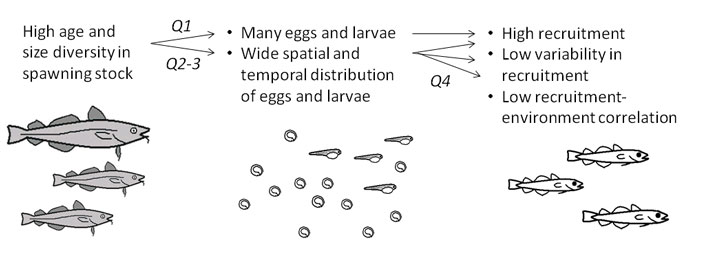This story starts several decades ago. In 1959 Soviet scientists started systematic surveys to count and map the distribution of the eggs and larvae of fishes in the Barents Sea ecosystem. In particular, the Barents Sea cod was of interest. This cod stock, referred to as “skrei” in Norwegian, has been fished at the spawning grounds along the Norwegian coast for at least 1000 years (Egil’s saga). It is currently the world’s largest cod stock and is jointly managed and harvested by Norway and Russia. The Russian surveys covered most of the distribution area of the cod eggs, which drift with the currents along the Norwegian and Russian coasts into the Barents Sea – the nursery area of the juveniles and the feeding area of the adult cod. In 1993 the annual surveys stopped but the data from the surveys have only recently been computerized. This computerization was a Russian-Norwegian collaboration involving the Knipovich Polar Research Institute of Marine Fisheries and Oceanography (PINRO) in Murmansk, the Institute of Marine Research (IMR) in Bergen and the Centre for Ecological and Evolutionary Synthesis (CEES) at the University of Oslo. Now papers presenting joint analyses of this gold mine of data are coming out (see blog posts here, here and here). The newest work using these data was published this week in the Proceedings of the National Academy of Sciences of the United States of America (Stige et al. 2017) and investigates a “missing link” in our knowledge about how demographic structure of fish stocks influence their recruitment.
It is well established that high fishing pressure influences the age and size structure of fish stocks. This happens whether or not fisheries target specific size-ranges of fish, as the high mortality per se reduces the proportion of fish that reach high age and size. This effect is often magnified, however, by fisheries targeting large and commercially valuable fish. The result is that many heavily fished fish stocks have experienced a trend towards increased dominance of small and young fish.
The large and experienced fish are thought to be of particular value for the population, as they often have high reproductive capacity, they can put more resources into each egg and they can spawn at locations or periods that may be energetically too “expensive” for younger and smaller conspecifics. A population with many old and large individuals, so-called BOFFFS (big, old, fat, fecund, female fish), has a higher diversity of spawning strategies than a population with few BOFFFFs. One result of this is that the offspring are likely to be distributed over a large area, which is thought to “buffer” environmental influences on different patches of fish eggs and larvae and increase the chance that at least some offspring survive through the first, dangerous months of life. As indeed supported by some studies, loss of BOFFFFs may impair the reproductive capacity of the stock, as measured by the number of fish that survive to an age when they can be fished (called “recruitment” in fisheries science) and the sensitivity of recruitment to climate fluctuations. Other studies have, however, failed to detect associations between age and size structure and recruitment. There is therefore disagreement whether the value of conserving intact age and size structure in harvested fish stocks is overemphasized or underappreciated.
Our new study contributes to fill a knowledge gap here, by analysing realized cod egg distributions. Most previous research has either been correlating measures of age and size structure directly with recruitment, or been more short-term observational or experimental. Benefiting from the extensive monitoring efforts of Russian scientists over more than 30 years, we now had the possibility to investigate the presumed mechanisms that link age and size structure to recruitment. During the period analysed (1959−1993), fishing pressure on the Barents Sea cod was increasing and the mean age of the spawners decreased from around 9−10 years to around 7−8 years, but with some variability year to year. We hypothesized (Fig. 1) that high mean age of spawners would coincide with high egg abundance (while accounting statistically for other factors affecting egg abundance, such as spawning stock biomass) and with a wide geographic distribution of eggs, and that a wide geographic distribution of eggs would coincide with high survival to later ages and low sensitivity of survival to temperature.
The two first hypotheses were confirmed, but not the last. High mean age and weight of spawners was associated with high abundance and wide geographic distribution of eggs (Fig. 2), but we found no association between egg distribution and survival to later ages. We conclude that the buffering effect of a wide geographic distribution of offspring is probably of little quantitative importance for this stock.

Does this mean that we don’t have to worry about the consequences of the loss of the old and large individuals (BOFFFFs) from many heavily fished fish stocks? Not necessarily. Firstly, failure to detect an effect does not necessarily mean it is not there, and such buffering effects may be important in other stocks. Secondly, loss of BOFFFFs may have other consequences, such as genetic changes (evolution), and increased dependence on frequent strong year-classes, as there are fewer fish around that can outlive series of years with unfavourable environmental conditions. A piece of the puzzle is now in place, but there are more pieces to gather before we can see the whole picture.
Reference:
Stige, L.C., Yaragina, N., Langangen, Ø., Bogstad, B., Stenseth, N.C, & Ottersen, G. (2017). Effect of a fish stock's demographic structure on offspring survival and sensitivity to climate Proceedings of the National Academy of Sciences DOI: 10.1073/pnas.1621040114

Log in to comment
Not UiO or Feide account?
Create a WebID account to comment